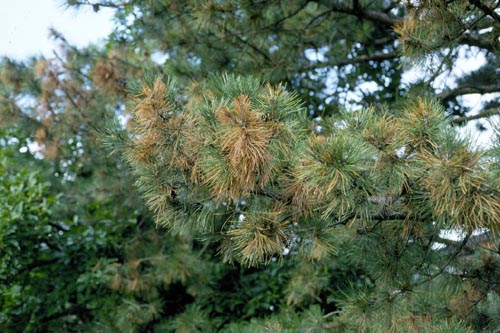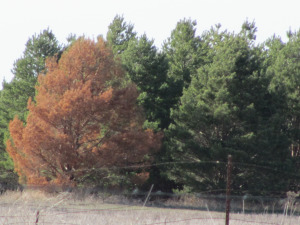Trees in our area can suffer from a variety of tree diseases, funguses and insect infestations. At KC Arborist, we are always on the lookout for these tree problems. K.C. Arborist ISA certified arborists have a trained eye for where troubles may arise. Here in Kansas City we are one of the industryâs leading forces in disease and insect control. We continually stay current with our education and research for all forms of tree care services, including tree health care.
Observation Is the First Defense against Tree Disease in Kansas City
Our philosophy on tree health is prevention first. Thatâs where you come into the picture. If you see any signs of distress on your trees, call us. By catching it early, we can reduce initial stress to your trees and shrubs, and many disease and insect problems can be avoided or at the very least, nipped in the bud.
Pine Tree Diseases in Kansas
Pine trees, in particular, are vulnerable to environmental stresses, diseases, and insects. This guide should help you identify the various problems and report them to us sooner rather than later so your pine trees can be saved. The three most common and destructive pine tree diseases in Kansas include Sphaeropsis (Diplodia) Tip Blight, Dothistroma Needle Blight, and Pine Wilt.
Tip Blight (Sphaeropsis/Diplodia)
 Types of Trees Affected – Austrian, Ponderosa, Mugo pines
Types of Trees Affected – Austrian, Ponderosa, Mugo pines
Cause – Tip Blight is caused by a fungal disease.
Symptoms – Newly developing shoots are stunted and fail to grow. The emerging needles turn yellow or tan. Dried resin is often found on the dead shoot tips.
Treatment – Trees with tip blight should be adequately watered and fertilized to maintain tree vigor. Pine trees should be sprayed two times each spring to prevent fungal growth. Timing is key and the first application should be right when the new shoots are expanding in the spring, usually around the 3rd week of April. The second application should follow on a 14-21 day cycle. With this disease, prevention is key.
Dothistroma Needle Blight
 Types of Trees Affected – Austrian, Ponderosa, mugo pines (Scots Pine, also called Scotch Pine, is resistant).
Types of Trees Affected – Austrian, Ponderosa, mugo pines (Scots Pine, also called Scotch Pine, is resistant).
Cause – The fungus, Dothistroma septospora, overwinters in infected needles and produces small, black, spore-bearing structures (acervuli), which break through the dead needle epidermis in late winter or early spring.
Symptoms – The disease causes premature needle drop the year after infection. Austrian and ponderosa pines usually retain needles for 3 to 4 years, so the loss of 2-year-old needles is a loss of important photosynthetic capacity. Repeated infection over many years can kill a tree.
Treatment – Some copper-containing fungicides can be used for control. A single spray for fungus in early June normally will protect foliage from infection. Because susceptible older needles are not protected in late May, two fungicide applications in mid-May and mid- to late-June provide a more complete and dependable control.
Pine Wilt
 Types of Trees Affected – Scots pines are particularly susceptible. Austrian, white, and mugo pines are also hosts, but they are not as susceptible as Scots pine.
Types of Trees Affected – Scots pines are particularly susceptible. Austrian, white, and mugo pines are also hosts, but they are not as susceptible as Scots pine.
Cause – Pine wilt is caused by the pinewood nematode, which is spread by the pine sawyer beetle. The nematode feeds and multiplies in the treeâs resin canals, causing wilting and death in several weeks to several months. The nematode and beetles spend the winter in the infected tree. The beetles emerge around May 1st, carrying nematodes to new trees and continuing the cycle of infection.
Symptoms – Trees wilt and die in a short period of time, from several weeks to a few months. In the first stages, the needles turn grey or green, then yellow and brown. The discoloration sometimes occurs branch by branch, sometimes all at once.
Treatment – The most important step in control is sanitation. Call a professional. If the tree is infected, it should be cut down as soon as possible and the stump should be removed. Removal of infested trees needs to be prompt, by May 1st at the latest, before the beetles emerge and begin to infest healthy trees. Chip or burn the wood immediately to destroy the beetles and nematodes.
If you suspect disease, insect infestation or fungus, call the pine tree disease experts at KC Arborist. We can provide applications to protect your pines as well as remove trees which are too far gone. Remember that prevention and a proactive approach is key to keeping these pine tree diseases under control.
We are your Kansas City tree disease and insect control experts, so call us at (913) 390-0033 or (816) 965-0539 to set up and evaluate.
Â









